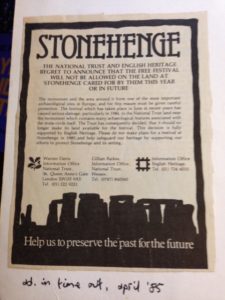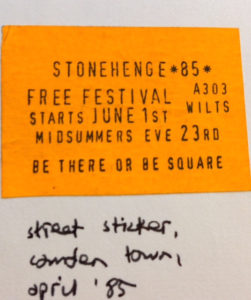[On the occasion of the centenary of public ownership of Stonehenge]
In 1985 I was squatting in the city of London. On 10 April I bought somewhere a copy of Michael Balfour’s book, Stonehenge and its Mysteries. I’d been at the festival the previous year, and found it a powerful, challenging and liberating experience. No doubt I wanted to know a bit more about the stones, and their history, ownership, meaning. It must have been one of the only books I actually bought round then, because I was living light at the time, of course.
In the book, which I still have, there are pasted on the inside front cover, below my name and place/date of publication, these two pieces of print media. One is from a London listings magazine, the other from a lamp post in the street. At the time I knew they represented the poles of opinion or value around heritage and identity, and thought of them as competing versions of Englishness.
With the so-called Battle of the Beanfield two months later—hundreds of travellers and festival-goers en route to the stones ambushed by a seemingly out-of-control English police force, violently attacked and homes destroyed—these opinions and values around heritage and identity were starkly politicised, though of course they had been about politics, land and life all along.


